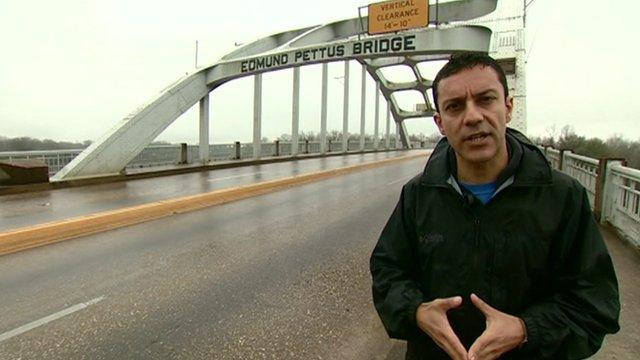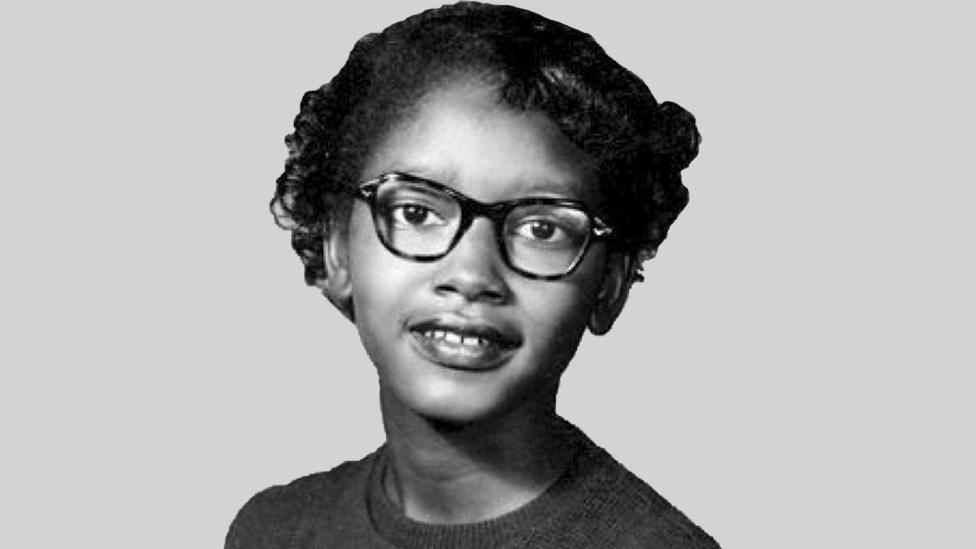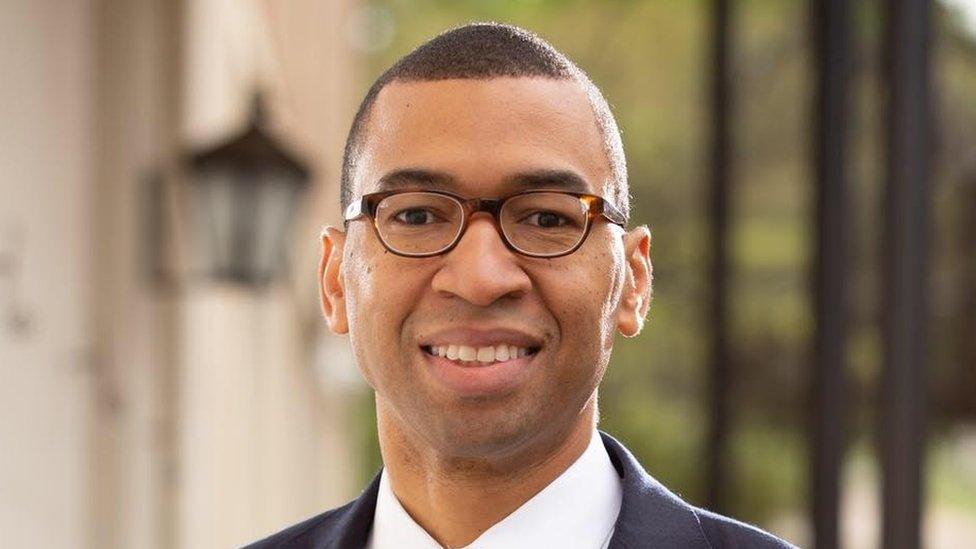Tears. Shock. Joy. Why viral Alabama boat brawl matters
- Published

A violent brawl erupted on a boating dock in Montgomery on Saturday. And America hasn't stopped talking about it since.
In the days after, dozens of video recordings circulated on social media, showing fists flying, a chair being slammed onto someone's head, and a man swimming toward the dock to join the fight.
Some described it as "the best fight I've ever seen". But the videos of the violent uproar have also struck a chord with black Americans, who saw the fight - mostly divided along racial lines - as emblematic of the country's racist past, and a symbol for the ongoing fight for equal rights.
The setting of the brawl made the moment more poignant for some: Montgomery, Alabama, is known to be the birthplace of the Civil Rights Movement, the name given to the battle for racial equality in the US which, in the eyes of some, has not ended.
"In short, I cried," said Candyce Anderson. "My tears were of grief. This is a grieving process… these are tears that our grandparents weren't able to cry."
Though she was not there to witness the incident when it happened, she was at the scene earlier that day.
Along with a dozen other women, she had gone to the dock to drop rose petals in the water to "honour our ancestors".
"The path that we walked to the waterfront, just a block away was the path that our enslaved ancestors walked, brought into Montgomery in chains," she said. "We cannot ignore the history, the ground on which this took place."

Candyce Anderson, a resident of Montgomery, Alabama, experienced sorrow and fatigue in the fight's wake
What happened?
The man seen receiving the first blow was a black man who, in the words of Montgomery police chief Darryl Albert, was simply "doing his job".
Damien Pickett was a co-captain of the Harriett II, a riverboat carrying over 200 passengers that needed to dock but couldn't. A much smaller pontoon boat was wrongfully docked in the Harriett II's designated space.
The occupiers of the pontoon boat were white men. Instead of moving their pontoon, they decided to hit Mr Pickett.
But before police could arrive and quell the violence, chaos erupted. Roughly two dozen people had joined the fight.
Three men and one woman have turned themselves in after arrest warrants were issued by the Montgomery Police Department, and have been charged with assault. A fifth person, the man seen wielding the chair in the video, has been called in by police for questioning.
Montgomery police so far have said they do not believe the incident was racially motivated. No hate crime-related charges or riot charges are expected, although the investigation is ongoing. Court documents show that an eyewitness - the white mother of a teenage boy working alongside the co-captain - reported hearing the men use racial slurs moments before launching the attack.
From past to present
Mrs Anderson said the sentiment among the city's black community since the incident was one of fatigue, and solidarity with men who joined with the boat co-captain as he stood his ground.
"When a [boat co-captain] is just doing his job and saying you can't dock here you have to move, and he's met with aggression and racial slurs, that is telling of what many citizens in this city have endured for years," she said.
"This time it was - 'Enough is enough.'"
The fatigue, Mrs Anderson said, dates back hundreds of years.
When many black people think of Montgomery, they think of the city that was once the capital of the Confederate States of America; they think of the countless slaves dragged onto the riverfronts to be sold. They think about Rosa Parks' arrest for refusing to yield her seat to a white person; they think about where Martin Luther King Jr's house was bombed. They think about 'Bloody Sunday', the time when, in 1965, a group of non-violent protestors on their way to Montgomery were beaten and bloodied by police on horseback in Selma, Alabama.
Aleem Maqbool has been retracing the steps of the march 50 years on
It's with this history in mind, said Michael Harriot, a historian and author of Black AF History: The Un-Whitewashed Story of America, that the fight scenes on the Montgomery docks in 2023 were cheered by many.
"When people saw the black people, first of all, come to the defence of someone who was endangered and who happened to be black, and we saw the police respond by appropriately subduing the suspects, that's a rare thing to see," Mr Harriot said. "If you're on social media, you see a million videos of police brutality against black people, you see a million videos of people calling the police on black people for walking through white neighbourhoods… it is rare to see such an explicit example of justice being meted out."
As a result, "that caused a little bit of joy", Mr Harriot said.
Since the incident, countless memes, video re-enactments, and other humour-intended clips making light of the incident have flourished online. This includes the creation of a song called - the Montgomery Brawl.
"Seen a couple of them boys go night night," the creator of that song, Gmac Cash, raps. "And we got the first black man to swim to a fight. Salute!"
The song gained 1.6 million views in three days.
"When you see stuff like a song, that's a response that is - for lack of better words - part of our culture," Mr Harriot said. "We turn [something like the Montgomery incident] into a moment of black joy that can last."
When asked how black people can celebrate what appears to be an act of violence, Mr Harriot said: "I don't think we have to reconcile that or explain it. [Americans] celebrate moments of violence all the time. We valorise the Boston Tea Party. We valorise the Confederacy. We valorise so much violence in America and make it iconic.
"If that [memes and the song the Montgomery Brawl] is wrong, then America is wrong," he said.
Related topics
- Published2 March 2015

- Published10 March 2018

- Published9 October 2019
